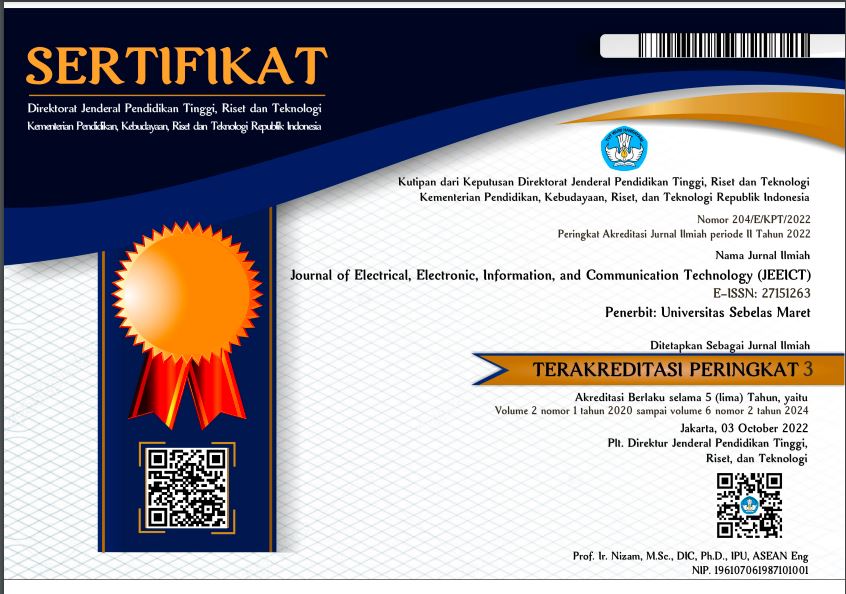Augmented Reality Implementation in Laptop Product Promotion Media Using Web-Based QR-Codes
Abstract
Technological developments were created for various needs, such as science, especially in the information field. This development has a very positive impact on technology users who promote electronic-based products. Augmented Reality is a tool to promote various products, especially to find out the specifications of electronic devices such as laptops, where users can view additional information relevant to the product being promoted via mobile devices such as smartphones or tablets. QR codes can also direct users to promotional websites that contain complete information about the laptop products being promoted. This research uses the MDLC (Multimedia Development Life Cycle) methodology to ensure that the built system can meet user needs and ensure effective use of AR and QR-code technology in laptop product promotion. The research stages consist of concept, design, material collecting, assembly, testing, and distribution. The results of the study show that the use of Augmented Reality as a promotional support medium is able to create innovative experiences for users, resulting in increased effectiveness in product promotion. By applying the Blackbox approach in testing application functions, the results show that all application components run according to predetermined expectations. The application of Augmented Reality technology in this application was carried out according to plan, successfully displaying product objects in 3D through the implementation of Augmented Reality.
Full Text:
PDFReferences
S. Saryani, N. Cholisoh, and G. Nurwana, "Design of Augmented Reality as a Promotional Media at the University of Raharja," Int. J. Cyber IT Serv. Manag., vol. 2, no. 2, pp. 95–103, 2022.
M. N. Fauzan and M. Kautsar, “Literatur Review Augmented Reality Sebagai Media Promosi Dengan Metode Marker Based Tracking,” Nuansa Inform., vol. 17, no. 2, pp. 83–93, 2023.
D. Tresnawati, D. D. S. Fatimah, and S. Rayahu, "The introduction of the solar system using augmented reality technology," in Journal of Physics: Conference Series, 2019, vol. 1402, no. 7.
J. Tizhe Liberty, S. Sun, C. Kucha, A. A. Adedeji, G. Agidi, and M. O. Ngadi, “Augmented reality for food quality assessment: Bridging the physical and digital worlds,” J. Food Eng., vol. 367, p. 111893, 2024.
L. Fitriani, D. Destiani, and H. Muhtadillah, “A Tourism Introduction Application Using Augmented Reality,” J. Online Inform., vol. 7, no. 1, p. 56, 2022.
T. K. Huang, C. H. Yang, Y. H. Hsieh, J. C. Wang, and C. C. Hung, “Augmented reality (AR) and virtual reality (VR) applied in dentistry,” Kaohsiung J. Med. Sci., vol. 34, no. 4, pp. 243–248, 2018.
X. Zhang, Z. Cao, and W. Dong, “Overview of Edge Computing in the Agricultural Internet of Things: Key Technologies, Applications, Challenges,” IEEE Access, vol. 8, pp. 141748–141761, 2020.
Y. Muharmi and S. Nadriati, “Aplikasi Media Promosi Kampus Stmik Dharmapala Riau Menggunakan Teknologi Augmented Reality,” INTECOMS J. Inf. Technol. Comput. Sci., vol. 6, no. 1, pp. 487–493, 2023.
A. Sutedi, D. Tresnawati, and R. Faiz, “Perancangan Aplikasi Promosi Katalog Mebel Menggunakan Teknologi Augmented Reality,” J. Algoritm., vol. 19, no. 1, pp. 210–218, 2022.
K. W. Anugrah and A. N. Alfian, “Augmented Reality Sebagai Media Pembelajaran Komponen Utama Mesin Mobil Berbasis Android,” J. Mhs. Bina Insa., vol. 5, no. 1, pp. 21–32, 2020.
A. Latifah, D. Tresnawati, and H. Sanjaya, “Media Pembelajaran Menggunakan Teknologi Augmented Reality untuk Tanaman Daun Herbal,” J. Algoritm., vol. 19, no. 2, pp. 515–526, 2022.
N. H. C. Lah, M. S. Z. M. Senu, N. F. Jumaat, D. N. E. Phon, S. Hashim, and N. N. Zulkifli, “Mobile augmented reality in learning chemistry subject: an evaluation of science exploration,” Int. J. Eval. Res. Educ. , vol. 13, no. 2, pp. 1007–1020, 2024.
D. D. S. Fatimah, R. Kurniawati, I. Farida, and Y. Pariyatin, “Website for remote village empowerment in developing countries,” in Journal of Physics: Conference Series, 2019, vol. 1402, no. 7.
N. N. Huda and C. Rejito, “Modeling University Business Incubator For SMEs Digitalisation,” Indones. J. Inf. Syst., vol. 3, no. 1, pp. 23–37, 2020.
N. L. W. S. R. Ginantra, I. M. D. P. Asana, W. G. S. Parwita, and I. W. E. Eriana, “Mobile-Based Customers Management System in Ayunadi Supermarket,” ADI J. Recent Innov., vol. 4, no. 1, pp. 86–101, 2022.
A. F. Ramadhan, ade dwi Putra, and A. Surahman, “Aplikasi Pengenalan perangkat keras komputer,” J. Comasie, vol. 6, no. 2, pp. 40–51, 2021.
I. T. Julianto, “Design And Build Virtual Reality Photography Web-Based To Support Tourism,” J. Electron. Electron. Information, Commun. Technol., vol. 3, no. 2, p. 58, 2021.
D. D. S. Fatimah, A. Latifah, and H. Haniyah, “Implementasi Augmented Reality Sebagai Media Pembelajaran Kata Benda Bahasa Arab pada Siswa Sekolah Dasar Islam Terpadu,” J. Algoritm., vol. 19, no. 2, pp. 781–789, 2022.
R. Situmorang, C. Kustandi, and ..., “… -based Digital Flashcard as a Media for Promotion and Socialization to Increase the Competitiveness of the Creative Economy and Small and Medium Enterprises,” … Conf. Educ. …, vol. 372, no. ICoET, pp. 58–63, 2019.
A. Y. Pangestu, R. Safe’i, A. Darmawan, H. Kaskoyo, and R. Andrian, “Black-Box Testing on Web-GIS of Forest Health Monitoring Using Equivalence Partitioning Techniques,” AIP Conf. Proc., vol. 2563, no. October, 2022.
Refbacks
- There are currently no refbacks.







